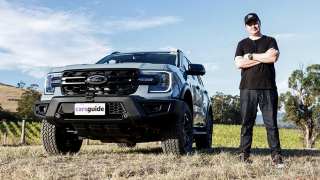
ADF gets first G-Wagens
- Land Rover Defender
- Land Rover Defender 2010
- Land Rover News
- Mercedes-Benz News
- Land Rover SUV Range
- Mercedes-Benz SUV Range
- SUV
- Land Rover
- Mercedes-Benz

The ADF this week took delivery of nine G-Wagen models, which are part of a 1200-strong order placed in 1998. The Austrian built G-Wagens will eventually replace the current fleet of British Land Rover Defender models currently used for cross country work.
They are part of the Project Overlander program, under which 7000 field and land vehicles and trailers will be sourced between 2011 and 2018. The ADF is yet to announce which medium and heavy vehicles it plans to purchase under the program.
It has recently tested trucks from MAN, BAE Systems, Thales Australia, Oshkosh and Mercedes at its Townsville and Puckapunyal to select the most appropriate vehicle. The Mercedes models on test included an armoured four-wheel drive and six-wheel drive versions of the Zetros and the armoured eight-wheel drive Actros.
The nine Mercedes G-Wagens, which join two models that were handed over to the ADF in Austria late last year, will be tested thoroughly to check for any gremlins before full production of the fleet cranks up later this year. Mercedes will supply the ADF with several different versions of the G-Wagen including a four-wheel drive wagon, a four-wheel drive cab-chassis, six-wheel drive single cab and six-wheel drive dual-cabs.
As part of the ADF push to have more equipment sourced direct from the factory, Mercedes will also offer a armour kits for all vehicles. Australian engineering company G.H Varley will fit out many of the vehicles with custom-made modules which will be detachable. These will allow the G-Wagens to be used for a range of tasks including the transfer of munitions, carry troops or be used as an ambulance.
The ADF says using detachable modular unit design has evolved since World War II and allows for increased flexibility and reduces the need for purpose built vehicles that can only be used for limited duties. The military G-Wagen models, made at the Magna Steyr plant in Graz, Austria, run can carry up to two tonnes and have a range of 600km to 800km.
They run a 3.0-litre common rail V6 which complies with Euro 5 emission standards and has an average fuel consumption figure of 13.7 litres per 100km. The ADF plans to fit the vehicles with electronic vehicle diagnostic systems to monitor the fleet and properly maintain it, a first within the Force.








Comments